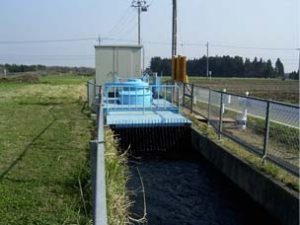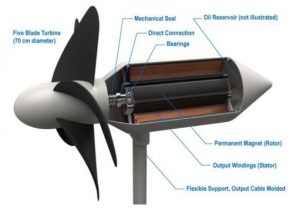In this blog post, I have decided to discuss regarding renewable energy projects in Japan specifically mini- & micro-hydroenergy after the collapse of public trust in nuclear energy following the Triple Disaster in 3rd March 2011. Mini- to Micro-hydropower’s advantage does not include damming up large rivers (which is not necessarily environmentally friendly-Pros and cons of dams) but rather harnessing the power of flowing water – in spite of whether it is a natural river, stream, public reservoir or even the power of wave currents in oceans.
More information about the Tohoku earthquake & Tsunami in 2011: https://en.wikipedia.org/wiki/2011_T%C5%8Dhoku_earthquake_and_tsunami

Fig.1.The Momura Micro Hydro Power Plant in Japan via Mini-Hydro Power Plants in Irrigation Canals
Five years ago, Japan introduced a feed-in tariff (FiT) system — a policy that helps accelerate investment in renewable energy technologies by having the utilities offer to purchase electricity at predetermined rates from renewable energy producers in long-term contracts. In 2017 quarterly statistics for Japan placed the total share of renewable electricity production at 20.7%. These were divided into five categories: in which hydropower (10.2%) contributed the majority of all other renewable energies.
Environment Ministry in Japan defined “Large” hydro-power plants as generating more than 100,000kW, “Medium” generate between 10,000 kw and 100,000 kw. “Small” hydro plants generate between 1,000 kw and 10,000 kw. “Mini” hydro plants generate between 100 kw and 1,000 kw, and “micro” hydro plants are those that generate less than 100 kw. Mini-hydropower is beneficial in rural areas with rivers and streams where mini-hydropower plants can be built and deliver electricity easily. Compared to other energy forms, mini-hydro has received noticeably less official attention. “Localized electricity production is efficient as it generates electricity at the site of consumption, without using large amounts of energy connecting to, and then being distributed from the transmission grid” (Suwa, 2009).
Dai Nakajima, a spokesman for the National Small Hydropower Association reckoned that the cost of mini-hydro electric power ranges between ¥15-¥100 per kilowatt-hour which is quite expensive, other problems facing mass introduction of hydropower plants including finding specific locations that has suitable water flow and legal regarding land- and water- issues pose a problem as well.
More on Pro & Cons of Mini-Hydro Power Plants in Irrigation Canals: http://www.turbulent.be/blog/mini-hydro-power-plants-in-irrigation-canals
Projects
Project Sea-Horse

Fig.2. Seahorse wave breaking device (2017) via CleanTechnica
Japan is keenly attuned to the problem of land erosion and has 30% of its coastline protected from the sea by wave breaking devices. Professor Tsumoru Shintake of the Okinawa Institute of Science and Technology University has proposed to redesign those devices to incorporate small turbines that generate electricity from oceanic water movement. Shintake has spearheaded a project labelled Sea Horse which aims to places turbines (full-scale turbines will include blades about two feet in diameter) tethered to the ocean floor to utilize ocean currents to generate power. The turbines are designed to withstand the tremendous force of ocean waves and safely operate in the surrounding marine environment inherent to Japan. The blades rotate at a carefully calculated speed to allow marine life to escape if they get caught among them. Sea Horse turbines are designed to have a minimum lifespan of approximately 10 years.
Micro hydro plant in Hiekawa

Fig.3. Micro hydro plant in Hiekawa (Japan) via TechnoTurbines Powering Water
The Micro hydro plant is located in Hiekawa (Japan) which channels water from the river through a pipeline, and needs a turbine to generate energy. This micro hydro plant produces enough energy in a sustainable way to sell it to the grid. The Tecnoturbines provides a Hydro-regen turbine to generate energy on a small scale and distribute it to the grid. This reduces dependence on nuclear energy, and encourages balanced distribution networks. Generating power from this micro hydro plant would reduce Co2 emissions by 485 ton CO2-eq.
Small Hydropower plant in Toyama Prefecture
There is a small hydropower plant in Toyoma Prefecture uses water flowing into rice paddies to generate electricity. There are 36 such facilities are operating in the prefecture in which Hiroo Minami is in charge of developing generation systems at a company there. Hokuriku Seiki (Minami’s firm) makes generators that can be used in canals where cascades are small. A generator may costs up to about $350,000 depending on its size and it’s very easy to install. This small power generator can be installed in streams where it can supply power to a place, which is off the grid – providing power to rural communities. Minami’s firm receieved an order from the Japan International Cooperation Agency where it will supply 2 of its power generators to a farming village about 500 kilometers from Myanmar’s largest city Yangon.
Pico & Micro Hydropower System by Nakayama Iron Works Ltd

Fig.4. Layout of compact micro hydro system via United Nations Industrial Development Organization
The “Micro Hydropower System” developed by Nakayama Iron Works Ltd., is a type of hydroelectric system that can produce a few kW to 1MW of electricity. This technology can produce electricity using small streams as a main resource for power generation. The company offers different types of hydro turbines that work under different range of head and discharges, hence being flexible, they are able to offer suitable turbines for respective sites. Some of its competitive advantage include the low cost to manufacture the micro turbine power system and the reduced cost for power generation by this system, which is significantly low compared to the cost by conventional power generation systems.
An Off Grid system would include an application of micro hydro turbine power system (or comined with photovoltaic power) within household network. An ON grid system would be installing the micro hydro turbines in rural areas that would help to connect to the Electric grid- which is an interconnected network of several power sources, such as solar, wind, and hydro electric plants.
References:
Hanley, S. (2017, October 2). Wave Power Renewable Energy Project Underway In Japan. In Clean Technica. Retrieved from https://cleantechnica.com/2017/10/02/wave-power-renewable-energy-project-underway-japan/
Johnston, E. (2017, October 14). Balance of power: Shift toward renewable energy appears to be picking up steam. In thejapantimes. Retrieved from https://www.japantimes.co.jp/news/2017/10/14/business/balance-power-shift-toward-renewable-energy-appears-picking-steam/#.WhxPRkqnGUlRkqnGUl
Micro hydro plant in Hiekawa (Japan) (n.d.). In Technoturbines Powering Water. Retrieved November 29, 2017, from http://tecnoturbines.com/portfolio/micro-hydro-plant-in-hiekawa-japan/?lang=en
Pico & Micro Hydropower System: Low-Cost Hydroelectric Generator (n.d.). In United Nations Industrial Development Organization. Retrieved November 29, 2017, from http://www.unido.or.jp/en/technology_db/1769/
Suwa, A. (2009, December 12). How Things Work: Micro Hydroelectricity in Japan. In Our World. Retrieved November 29, 2017, from https://ourworld.unu.edu/en/rice-water-power-micro-hydroelectricity-in-japan
Small Hydropower Devices Making Big Waves (2017, January 26). In NHK World. Retrieved November 29, 2017, from https://www3.nhk.or.jp/nhkworld/en/news/editors/3/smallhydropowerdevicesmakingbigwaves/index.html